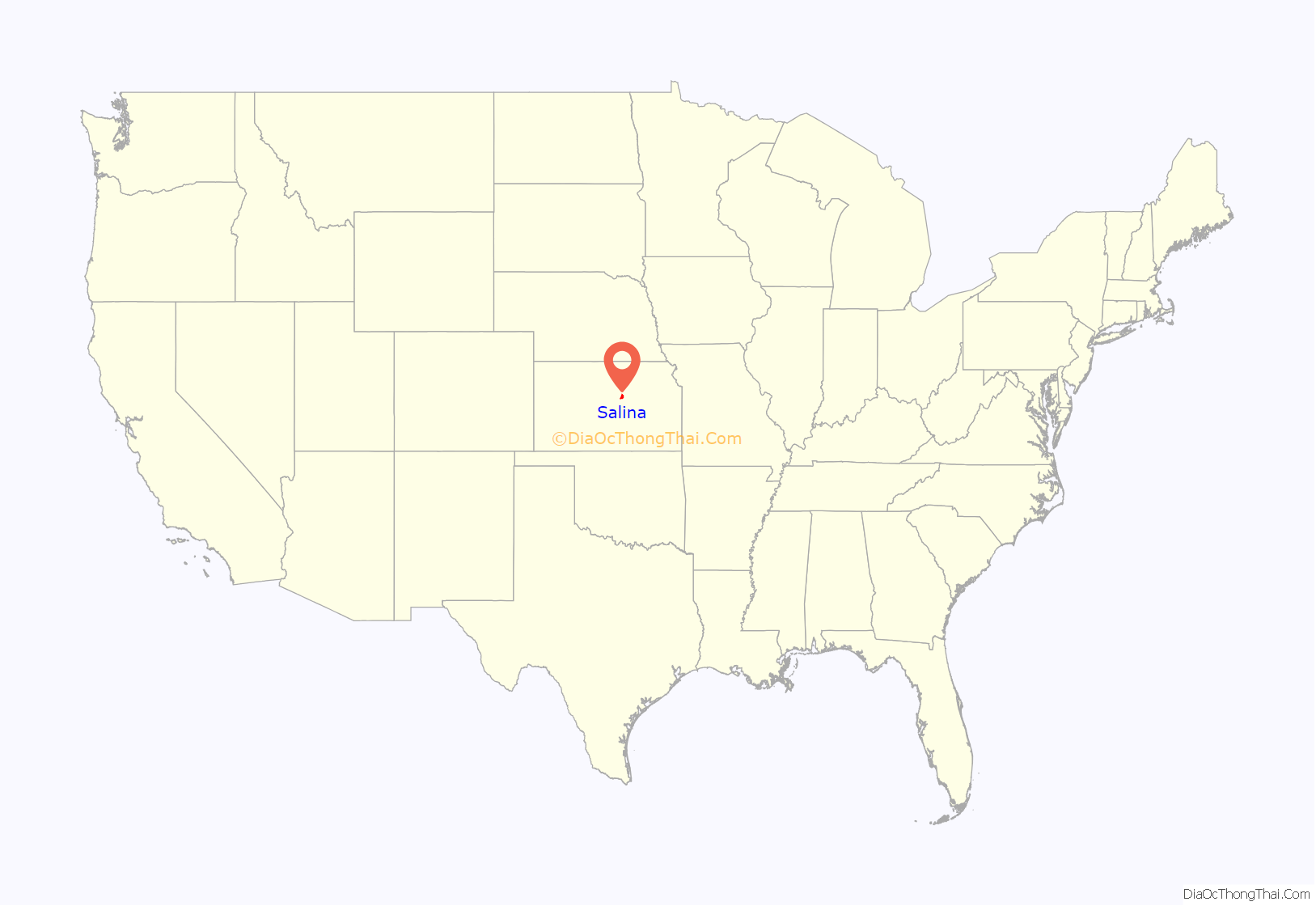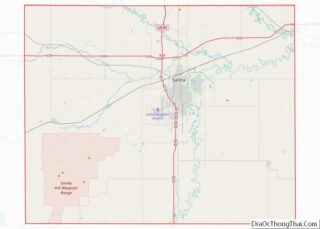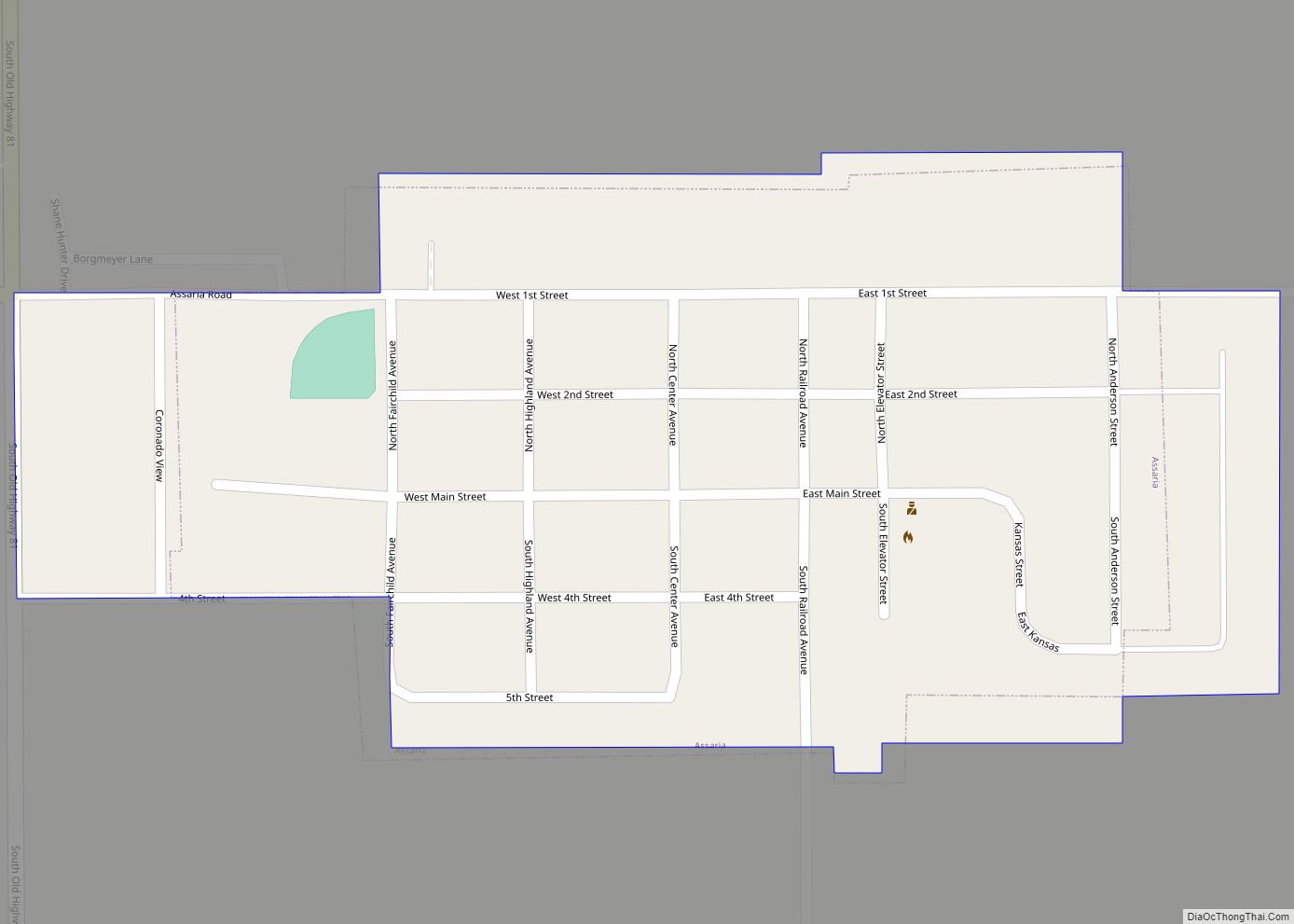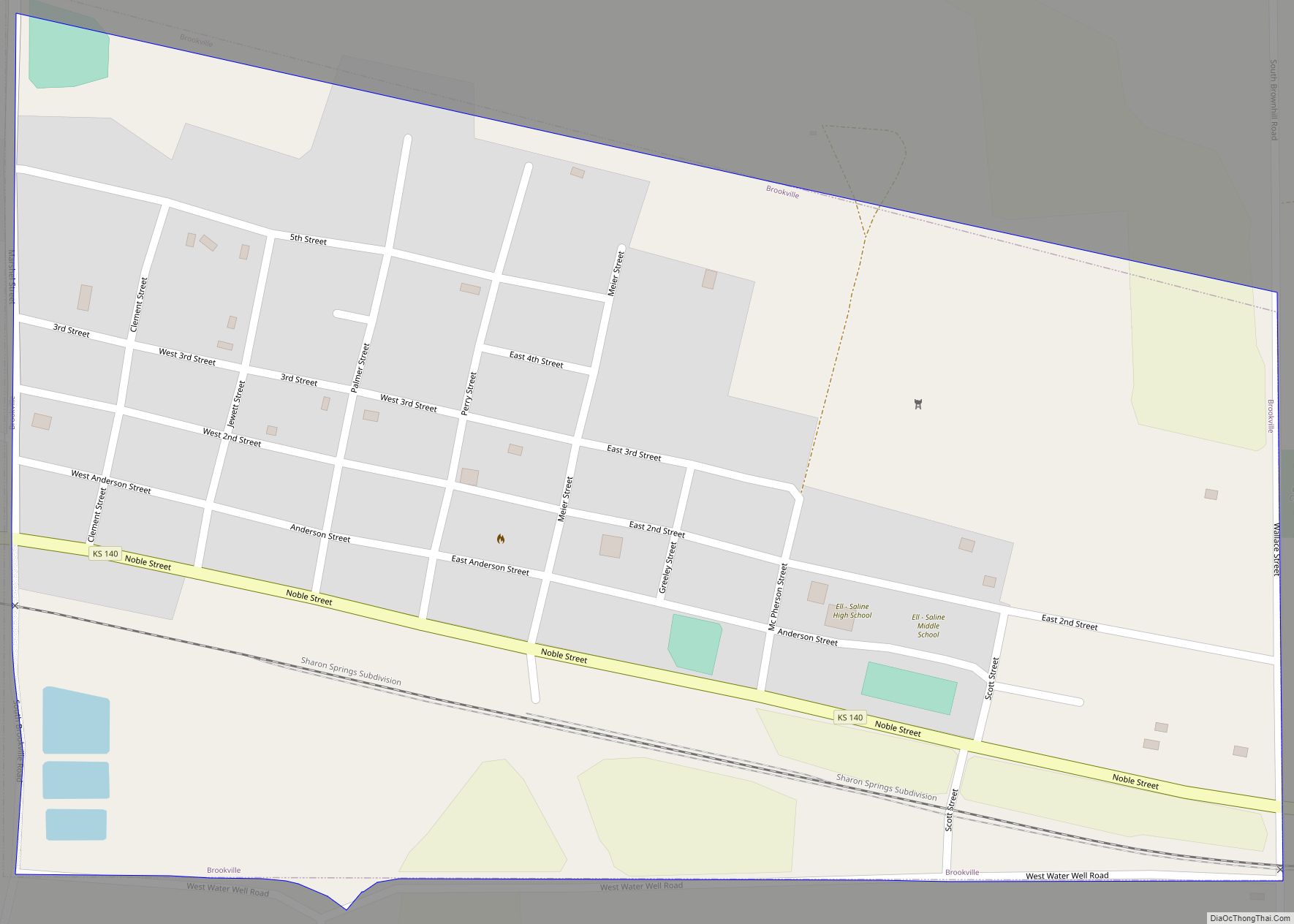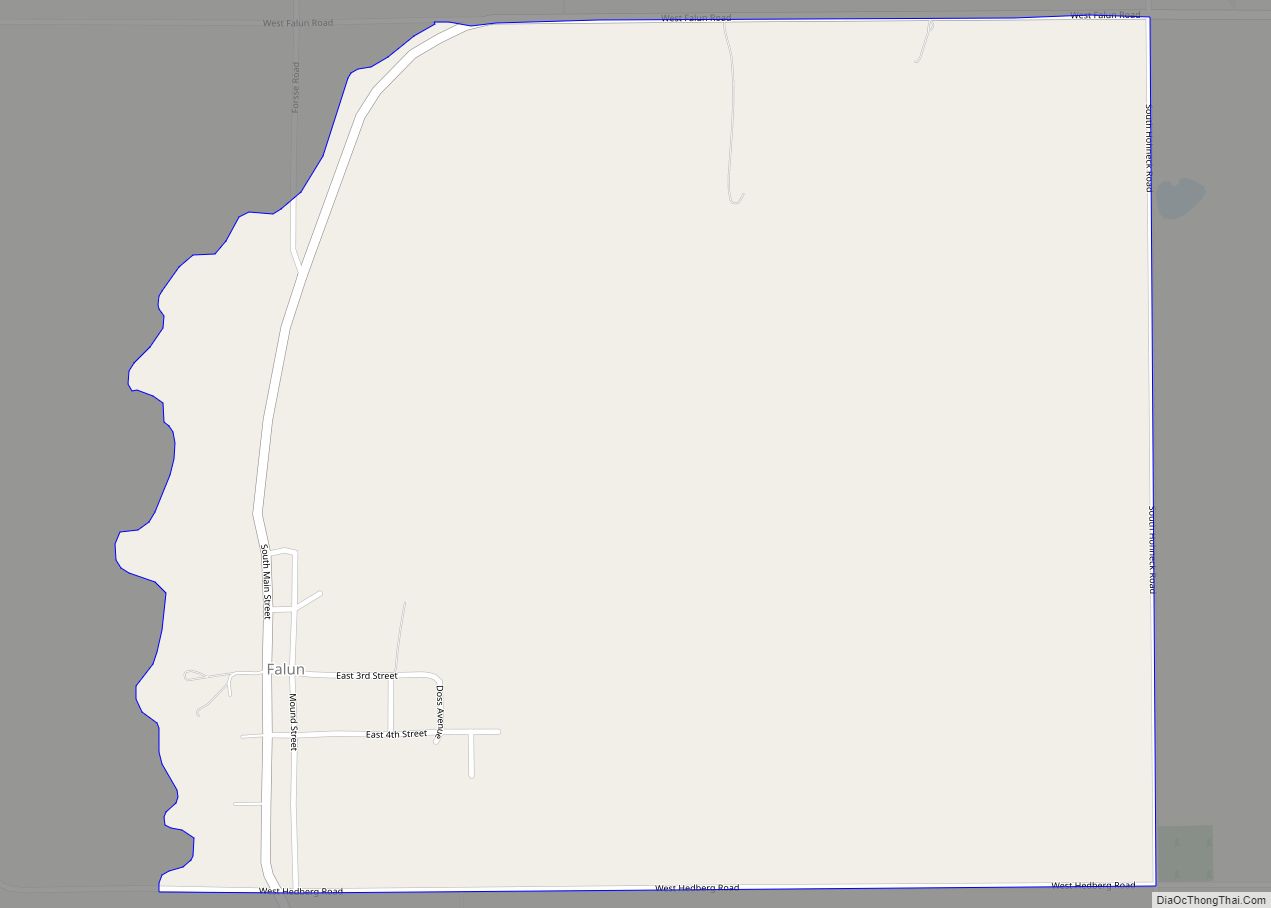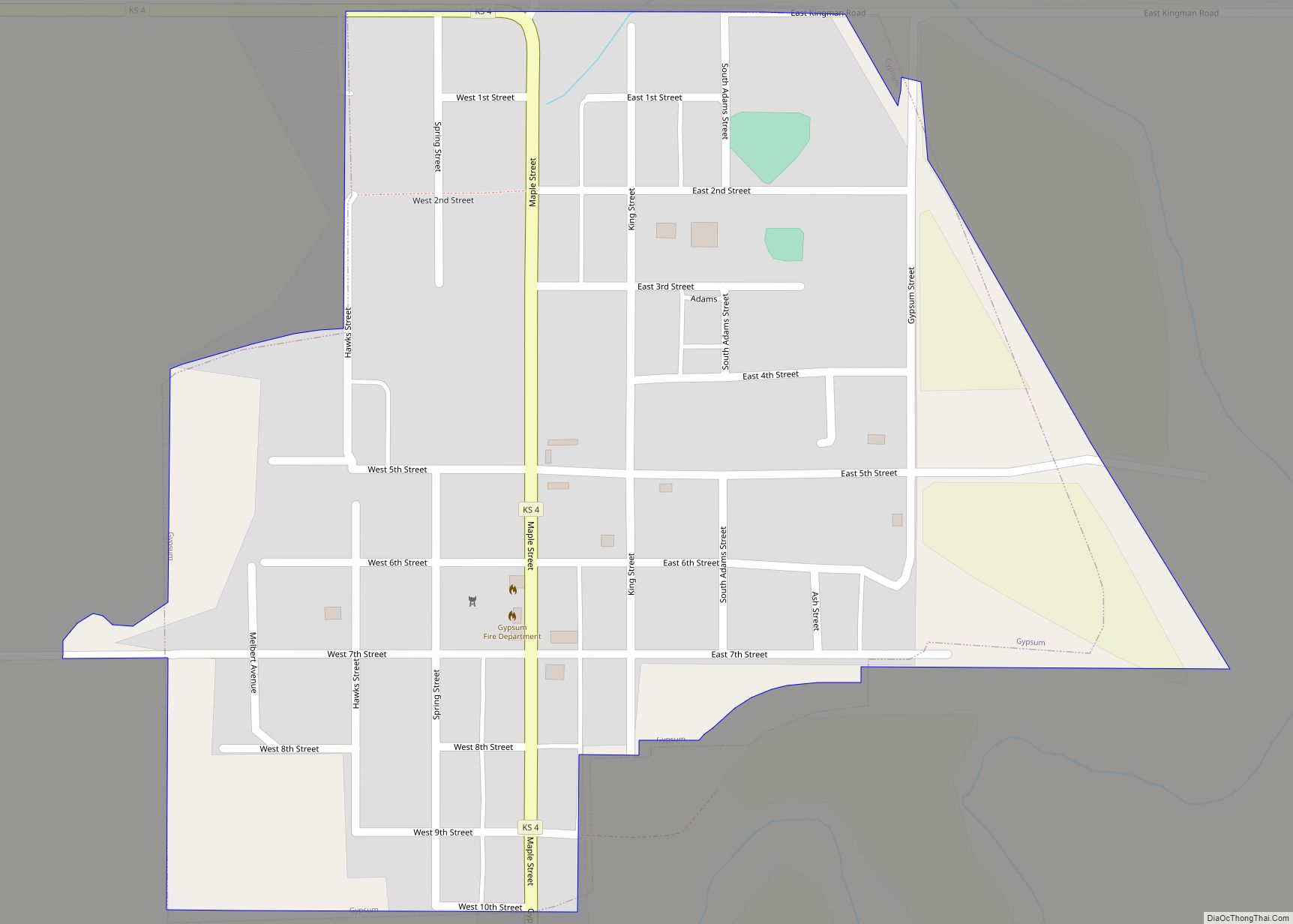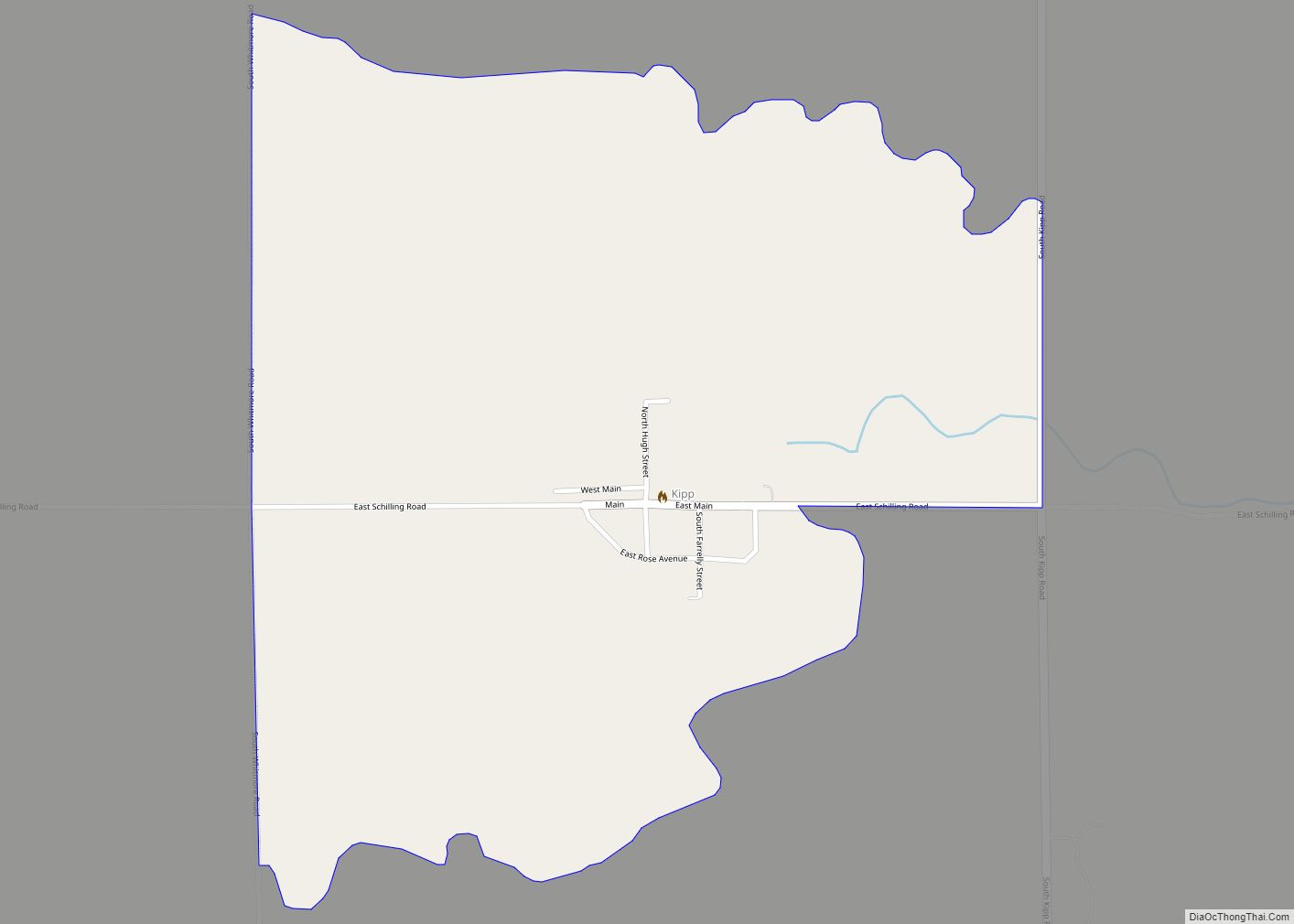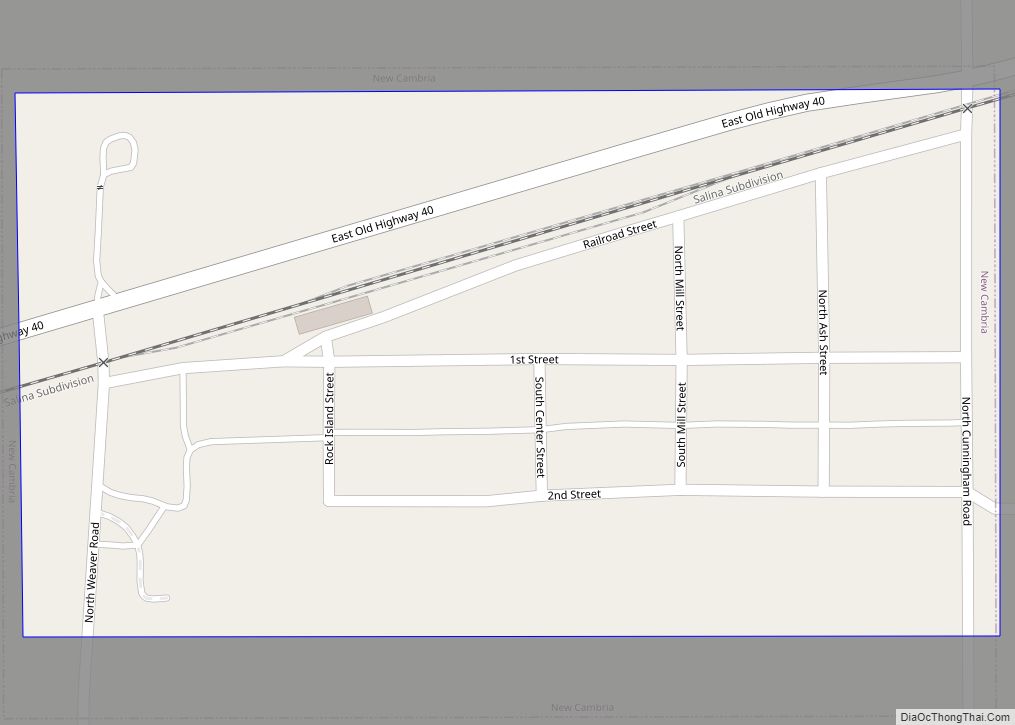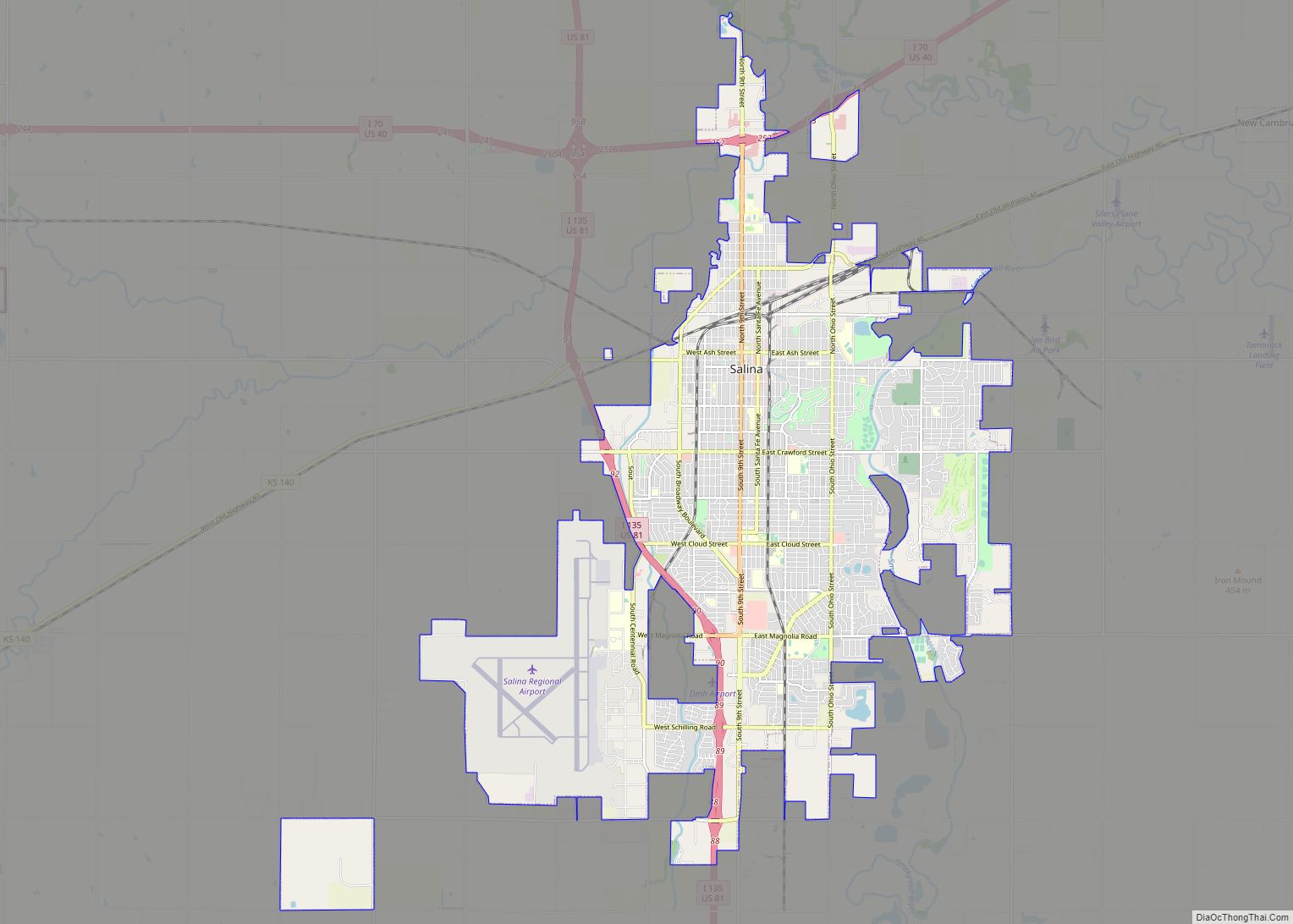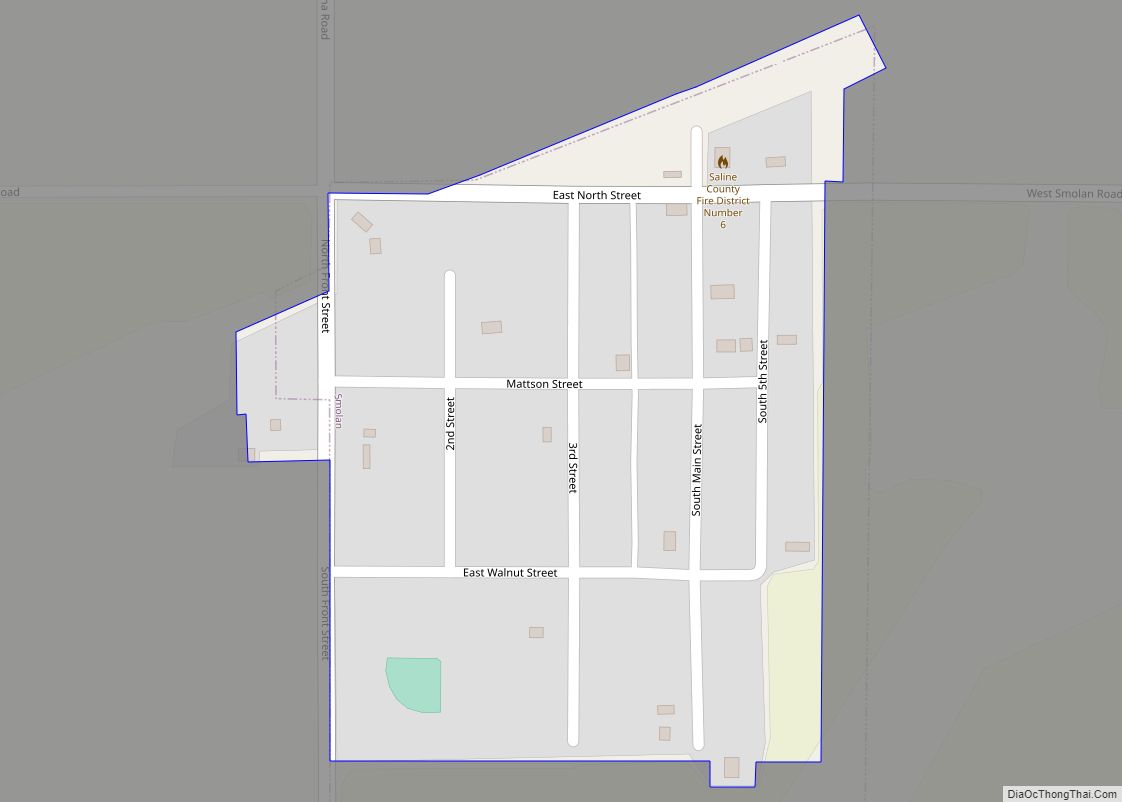Salina /səˈlaɪnə/ is a city in and the county seat of Saline County, Kansas, United States. As of the 2020 census, the population was 46,889.
In the early 1800s, the Kanza tribal land reached eastward from the middle of the Kansas Territory. In 1858, settlers from Lawrence founded the Salina Town Company with a wagon circle, under constant threat of High Plains tribal attacks from the west. It was named for the salty Saline River. Saline County was soon organized around this township, and in 1870, Salina incorporated as a city.
As the westernmost town on the Smoky Hill Trail, Salina boomed until the Civil War by establishing itself as a trading post for westbound immigrants, gold prospectors bound for Pikes Peak, and area American Indian tribes. It boomed again from the 1940s-1950s when the Smoky Hill Army Airfield was built for World War II strategic bombers.
It is now a micropolis and regional trade center for North Central Kansas. Higher education institutions include the KSU College of Technology and Aviation and Kansas Wesleyan University; and employers include Tony’s Pizza, Exide Battery, Great Plains Manufacturing, and Asurion.
| Name: | Salina city |
|---|---|
| LSAD Code: | 25 |
| LSAD Description: | city (suffix) |
| State: | Kansas |
| County: | Saline County |
| Founded: | 1858; 165 years ago (1858) |
| Incorporated: | 1870 |
| Elevation: | 1,227 ft (374 m) |
| Total Area: | 25.74 sq mi (66.65 km²) |
| Land Area: | 25.70 sq mi (66.57 km²) |
| Water Area: | 0.03 sq mi (0.09 km²) |
| Total Population: | 46,889 |
| Population Density: | 1,800/sq mi (700/km²) |
| ZIP code: | 67401-67402 |
| Area code: | 785 |
| FIPS code: | 2062700 |
| Website: | salina-ks.gov |
Online Interactive Map
Click on ![]() to view map in "full screen" mode.
to view map in "full screen" mode.
Salina location map. Where is Salina city?
History
Native inhabitance: up to 1800s
Shortly prior to European colonization of the area in the early 1700s, the site that would become Salina was located within the western territory of the Kansa people. Claimed first by France as part of Louisiana and later acquired by the United States with the Louisiana Purchase in 1803, it was within the area organized by the U.S. as Kansas Territory in 1854. The French traders who mapped the forks of les Grande Riviere des Cansez, located the western village of les Cansez at the general confluence of the Smoky Hill, Saline, and Solomon Rivers with villages of the Paducas tribe just to the west on heads of those streams.
By the time of exploration of the prairie by the United States following the Louisiana Purchase in the early 1800s, the Republican Pawnee had established its influence in the Smoky Hills, driving the Kansa to its northeastern Kansas settlements.
The United States established forts throughout the territory to provide security for established commercial trade trails, including the Smoky Hill Trail and the Santa Fe Trail. The Smoky Hill Trail passed through the Salina site where the Fort Riley/Fort Larned Road split off to cross the Smoky Hill River to the southwest.
Battle of Indian Rock: 1857
By the time of the first tentative settlements by United States citizens, the site was claimed as hunting grounds by the High Plains tribes of Cheyenne, Arapaho, and Sioux, which had expanded into the area, driving out the Pawnee. However, the Kansa continued to hunt in the area, in which they were joined by the Delaware and Potawatomi tribes which had been relocated by the U.S. Government near the Kansa’s reserve and assured of hunting access to the plains. The High Plains tribes were hostilely opposed to both the U.S. settlers in central Kansas and to the relocated tribes in Eastern Kansas and Nebraska, who they also regarded as settlers, and there were several raids in the Salina area in the 1850s. These Indian skirmishes repeatedly discouraged settlement of the Salina site until 1857, according to William A. Phillips who resided in Lawrence while scouting settlement locations.
In that year, Big Chief of the Cheyenne led a party of the High Plains tribes. At Spring Creek, 20 miles west of what became Salina, they made a surprise attack on a hunting party of the “friendly” Eastern tribes. The hunting party retreated to Dry Creek, trapped and sending for help from another Kaw hunting party from Council Grove. Big Chief forced them to flee further to a butte in a bend of the Smoky Hill River, where they were joined by the Kaw reinforcements with rifles. Firing rifles from the cover of large sandstone boulders atop the butte, the defenders killed Big Chief on the first of five offensive charge attempts. His attacking bow and arrow force was devastated, leaving bodies strewn, and effectively ending the local raids.
The aftermath was recalled by settler Christina Campbell, “one of the fiercest and most cruel Indian battles known to white settlers; around were strewn thousands of arrows and implements of Indian warfare. Indian Rock, besmeared with blood, showed the part it played in repelling the repeated savages’ attacks. It was here that the Cheyenne made their last attack.”
Founding: 1858–1870
The defeat of the aggressive High Plains tribes had enabled the safe return of attempted settlers. In April 1858, journalist and lawyer William A. Phillips from Lawrence led the founding of Salina, accompanied by settlers David Phillips, Alexander M. Campbell Sr. (husband of Christina), A.C. Spillman, and James Muir. They were all Scotch Presbyterians, and all but Muir were related. From a west riverbank dugout at what is now Riverside Park, they camped and designed the first building. It was a two-story dwelling and Campbell’s store, at what is now the southwest corner of 5th St and Iron Ave near Founders Park. Constant tribal attacks required a wagon circle around the first water well one block west. The Campbells had the first surviving settler birth in the area, also named Christina.
That month, and still predating the 1861 statehood of Kansas, they chartered the Salina Town Company with the Kansas territory legislature. During the following year, they organized the surrounding area as Saline County, and named Salina the county seat. The westernmost town on the Smoky Hill Trail, Salina established itself as a trading post for westbound immigrants, gold prospectors bound for Pikes Peak, and area American Indian tribes. The town’s growth halted with the outbreak of the American Civil War when much of the male population left to join the Union Army.
In 1862, residents fended off Indian raiders and suffered a second assault by bushwhackers. In May and June 1864, the Salina Stockade was built to protect the town against further Indian raids. Union troops were garrisoned in Salina until March 1865, and some may have returned in June 1865. The building inside the stockade was remodeled and in September 1864 was opened as Salina’s first public school. The school term ran until March 1865. The use of the building probably continued until at least June 1865.
Growth returned with the soldiers after the war, and the town expanded rapidly with the arrival of the Kansas Pacific Railway in 1867. The construction of the railroad through Salina to Denver was a violation of treaty promises of Indian hunting grounds west of Salina, and Dog Soldiers began raiding the construction parties between Salina and Fort Wallace. The following U.S. military action removed Indians from western Kansas by 1868.
Salina incorporated as a city in 1870.
Growth: 1872–1950s
The cattle trade arrived in 1872, transforming Salina into a cowtown. The trade brought the city further prosperity, but also a rowdy culture that agitated local residents. The cattle trade relocated westward just two years later. During the 1870s, wheat became the dominant crop in the area, steam-powered flour mills were built, and agriculture became the engine of the local economy. In 1874, Salina resident E. R. Switzer introduced alfalfa to area farmers, and its cultivation spread throughout the state. By 1880, the city had become an area industrial center with several mills, a carriage and wagon factory, and a farm implement works. In 1889, the original garment factory of jeans maker Lee was opened. In the following decade, three railroads were built through the city. The success of the wholesale and milling industries drove Salina’s growth into the early 1900s, such that it was at one point the third-largest producer in the state and the sixth-largest in the United States.
In 1943, the U.S. Army established Smoky Hill Army Airfield southwest of the city. The installation served as a base for strategic bomber units throughout World War II. Renamed Smoky Hill Air Force Base in 1948, it was closed the following year and was reopened in 1951 as Schilling Air Force Base, part of the Strategic Air Command. The re-opening triggered an economic boom in Salina, causing the city’s population to increase by nearly two-thirds during the 1950s. The U.S. Department of Defense closed the base permanently in 1965, but the city of Salina acquired it and converted it into Salina Municipal Airport and an industrial park. This led to substantial industrial development, attracted firms such as Beechcraft, and made manufacturing a primary driver of the local economy.
The Salina micropolitan area is a center of trade, transportation, and industry in North Central Kansas.
Salina Road Map
Salina city Satellite Map
Geography
Salina is located at 38°50′25″N 97°36′41″W / 38.84028°N 97.61139°W / 38.84028; -97.61139 (38.8402805, -97.6114237) at an elevation of 1,224 feet (373 m). Located in North Central Kansas at the intersection of Interstate 70 and Interstate 135, it is 81 miles (130 km) north of Wichita, Kansas, 164 miles (264 km) west of Kansas City, Missouri, and 401 miles (645 km) east of Denver, Colorado.
Salina lies in the Smoky Hills region of the Great Plains approximately 6 miles (9.7 km) west-southwest of the confluence of the Saline and Smoky Hill Rivers. The Smoky Hill River runs north then northeast through the eastern part of the city; the Saline River flows southeast immediately north of the city. In the northeast part of the city, the old channel of the Smoky Hill branches from the river’s current course and winds west, north, and back east before draining back into the river. Mulberry Creek, a tributary of the Saline, flows northeast through the far northern part of the city. Dry Creek, a tributary of Mulberry Creek, flows north through the western part of the city.
According to the United States Census Bureau, the city has a total area of 25.15 square miles (65.14 km), of which 25.11 square miles (65.03 km) is land and 0.04 square miles (0.10 km) is water.
Climate
Salina lies in the transition area between North America’s humid subtropical (Köppen Cfa) and humid continental climate (Köppen Dfa) zones. Consequently, summers are typically hot and humid, and winters are typically cold and dry. On average, January is coldest, July is hottest, and May has the greatest precipitation.
Salina is in a region prone to severe thunderstorms with damaging winds, hail, and tornadoes. On June 21, 1969, an F3 tornado struck the southern part of the city, severely damaging or destroying more than 100 homes and businesses and injuring 60 people. On September 25, 1973, a second F3 tornado passed through the southeast part of town, injuring six people and destroying two houses and a trailer park. On June 11, 2008, another EF3 tornado passed on the south side of the town, severely damaging several buildings.
The annual average temperature in Salina is 56.1 °F (13 °C). The monthly daily average temperature ranges from 31.0 °F (−0.6 °C) in January to 81.1 °F (27.3 °C) in July. The high temperature reaches or exceeds 90 °F (32 °C) an average of 67.6 days per year and reaches or exceeds 100 °F (38 °C) an average of 15.9 days per year. The low temperature falls below the freezing point, 32 °F (0 °C), an average of 115.5 days per year and below 0 °F (−18 °C) an average of 2.1 days per year. The hottest temperature recorded in Salina is 118 °F (48 °C) on August 13, 1936; the coldest temperature recorded is −31 °F (−35 °C) on February 13, 1905.
On average, Salina receives 32.2 in (818 mm) of precipitation per year with the largest share being received from May to August. The average relative humidity is 64%. Snowfall averages 16.6 inches (42 cm) per year.
See also
Map of Kansas State and its subdivision:- Allen
- Anderson
- Atchison
- Barber
- Barton
- Bourbon
- Brown
- Butler
- Chase
- Chautauqua
- Cherokee
- Cheyenne
- Clark
- Clay
- Cloud
- Coffey
- Comanche
- Cowley
- Crawford
- Decatur
- Dickinson
- Doniphan
- Douglas
- Edwards
- Elk
- Ellis
- Ellsworth
- Finney
- Ford
- Franklin
- Geary
- Gove
- Graham
- Grant
- Gray
- Greeley
- Greenwood
- Hamilton
- Harper
- Harvey
- Haskell
- Hodgeman
- Jackson
- Jefferson
- Jewell
- Johnson
- Kearny
- Kingman
- Kiowa
- Labette
- Lane
- Leavenworth
- Lincoln
- Linn
- Logan
- Lyon
- Marion
- Marshall
- McPherson
- Meade
- Miami
- Mitchell
- Montgomery
- Morris
- Morton
- Nemaha
- Neosho
- Ness
- Norton
- Osage
- Osborne
- Ottawa
- Pawnee
- Phillips
- Pottawatomie
- Pratt
- Rawlins
- Reno
- Republic
- Rice
- Riley
- Rooks
- Rush
- Russell
- Saline
- Scott
- Sedgwick
- Seward
- Shawnee
- Sheridan
- Sherman
- Smith
- Stafford
- Stanton
- Stevens
- Sumner
- Thomas
- Trego
- Wabaunsee
- Wallace
- Washington
- Wichita
- Wilson
- Woodson
- Wyandotte
- Alabama
- Alaska
- Arizona
- Arkansas
- California
- Colorado
- Connecticut
- Delaware
- District of Columbia
- Florida
- Georgia
- Hawaii
- Idaho
- Illinois
- Indiana
- Iowa
- Kansas
- Kentucky
- Louisiana
- Maine
- Maryland
- Massachusetts
- Michigan
- Minnesota
- Mississippi
- Missouri
- Montana
- Nebraska
- Nevada
- New Hampshire
- New Jersey
- New Mexico
- New York
- North Carolina
- North Dakota
- Ohio
- Oklahoma
- Oregon
- Pennsylvania
- Rhode Island
- South Carolina
- South Dakota
- Tennessee
- Texas
- Utah
- Vermont
- Virginia
- Washington
- West Virginia
- Wisconsin
- Wyoming
